Jack Whitelock
Interview by David McLeavy
-
Published in May 2021
-
Talk to me about how you got into making paintings?
My paintings always start with either a single image that has caught my attention in some way or another, or they start as a very simple, half baked idea. Sometimes it’s as simple as me wanting my next painting to be monochrome, and seeing where that takes me. Which is what I did for a recent painting of a flamingo that eventually turned into something very different from my initial idea, and merged together with another piece. So my ideas/sources most of the time are just there to get me started and then forgotten about, as the process of making and the unexpected nature of painting takes over. I tend to plan my work and make digital collages/sketches on Photoshop, but even then when every stage is entirely planned, you still have no idea where it’s going to go. I think that excitement and urgency of wanting to know where a painting may end up is what drives me, until eventually something happens that finally reveals itself and it clicks. Alternatively this doesn't happen, which forces me to take more risks. But it’s in this mindset that I probably learn the most from.
One other way I go into making my paintings, which pops into my practise every now and again, is through finding objects and materials that I use in a semi object-painting way. At the moment I’m really into those self adhesive plastic hooks that I’ve been sticking to boards to paint on. They seem like teeth or thorns and have quite an unapproachable feel to them.
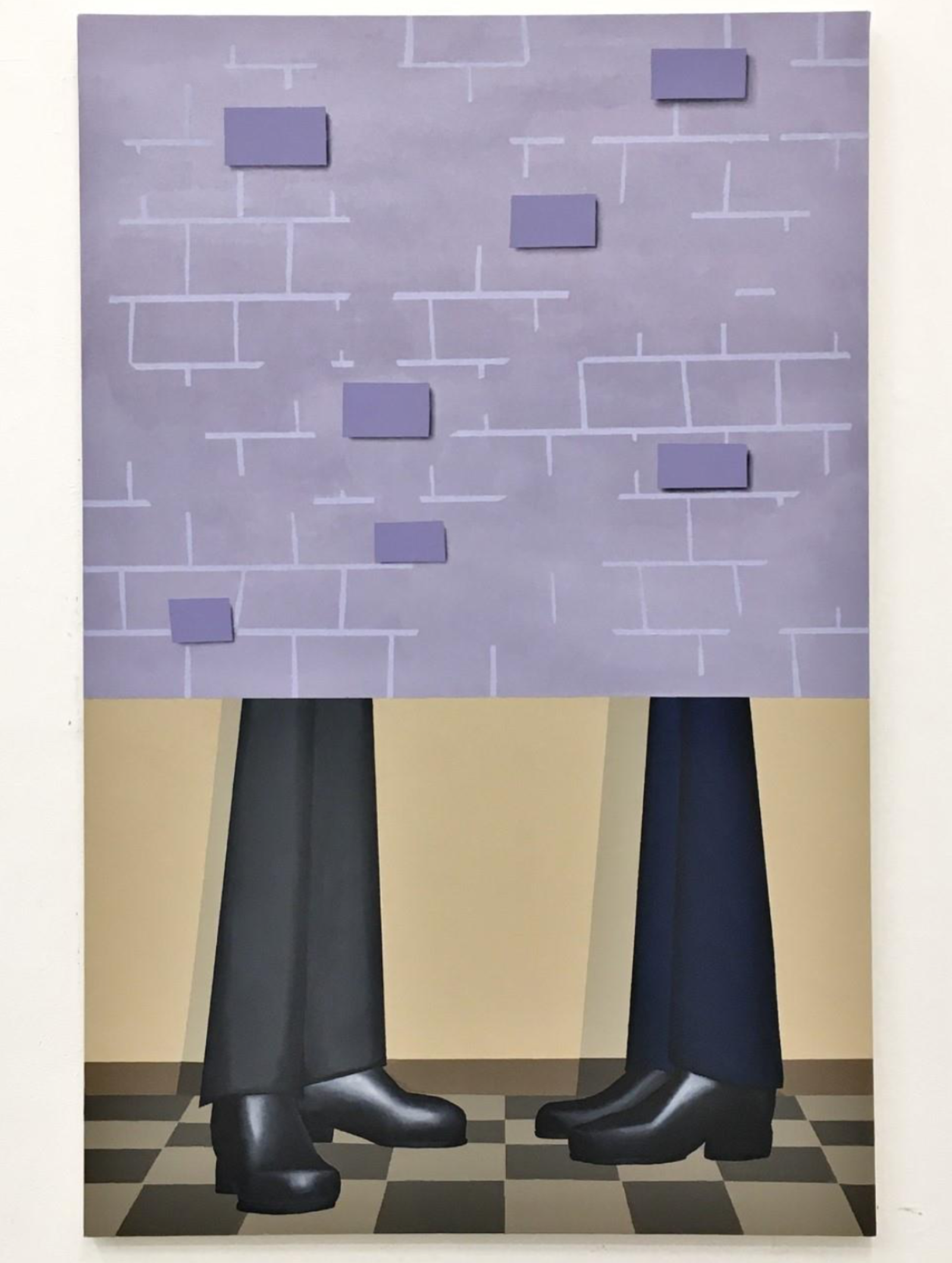 Shiny Boots Have No Laces, 2020. Image courtesy of John Whitelock.
Shiny Boots Have No Laces, 2020. Image courtesy of John Whitelock.Your paintings have a semi collaged feel to them, in the way that you use representational imagery, cropped against more patterned sections. I am thinking about the work you recently presented as part of the Freelands Painting Prize titled Shiny Boots Have No Laces, 2020, where you painted two figures in trousers and smart shoes, but decided to mask the top half of the image with a brick pattern.
I am interested to know how you decide on the imagery you end up including and if you think of this approach as a way of directing the viewer or suggesting a particular reading of the work?
I tend to choose the images by how I think they would translate in a painting, and certain qualities an image brings that could be presented through various methods and processes. For example, one part of an image might suit being painted with very gestural brush strokes or one section painted very flatly. Contextually the images can either add some kind of content or just be there to fill/create space. So sometimes I’ll have an image I really love, that in theory I think would make an interesting painting but when it comes to it, it doesn’t work due to how it translates into paint. Therefore, I can also have some images that I never think would work but then once placed with other sources, compositions and materials they come alive. So I would say it’s mainly the form of an image I’m looking at, over a contextual meaning, as when I look at my work, whether it’s representational or not I see it as entirely abstract. But I think with any kind of image shown through the context of an artwork it’s natural to project ideas and meaning onto them. Which is definitely something I do in an emotional sense, by how they feel to me, rather than what they could mean. It’s mainly a subconscious and intuitive process, and the majority of the time I have no reason why I choose them. After saying all this though, there is still strong conceptual meanings in the work about image circulation, appropriation, signifiers and the false narrator etc. that I find to be more of a symptom of the work, rather than me actively exploring those themes. But the meaning and content of the work for myself personally, comes from the process.
With Shiny Boots Have No Laces, the image itself is a screenshot from an animation of a rip off version of the film Ratatouille called Ratatoing. I came across it whilst researching appropriated films, and the image looked like it was a painting already, in it’s composition, surface and aesthetic. I thought there was something humorous and quite dumb in appropriating an already appropriated source, to keep the ball rolling. But that’s not the main reason why I chose it. It also has a quality to it that doesn’t fully reveal itself or give too much away, which is something I usually look for and try to present. I feel the best paintings are the ones that reveal themselves at first but then close away again, leaving you to find new ways in, making them more curious and ambiguous. I don’t think a painting should be too easy to read or ever have an ending, but should keep you trying to dig further into it. Which is why I like to combine representation with abstraction and formalism. I feel it stops the painting from becoming entirely about the image, and allows you to consider everything that’s infront of you. Including the dialogues between colours, forms, gestures, the size of the piece, the wall its on, the edges of the stretcher etc. Because you're never going to learn anything about who those two people are in the Shiny Boots piece or the types of trousers and shoes they have. But hopefully it provides more of a curiosity to the viewer and holds their interest long enough for them to feel or think something they wouldn’t have before.
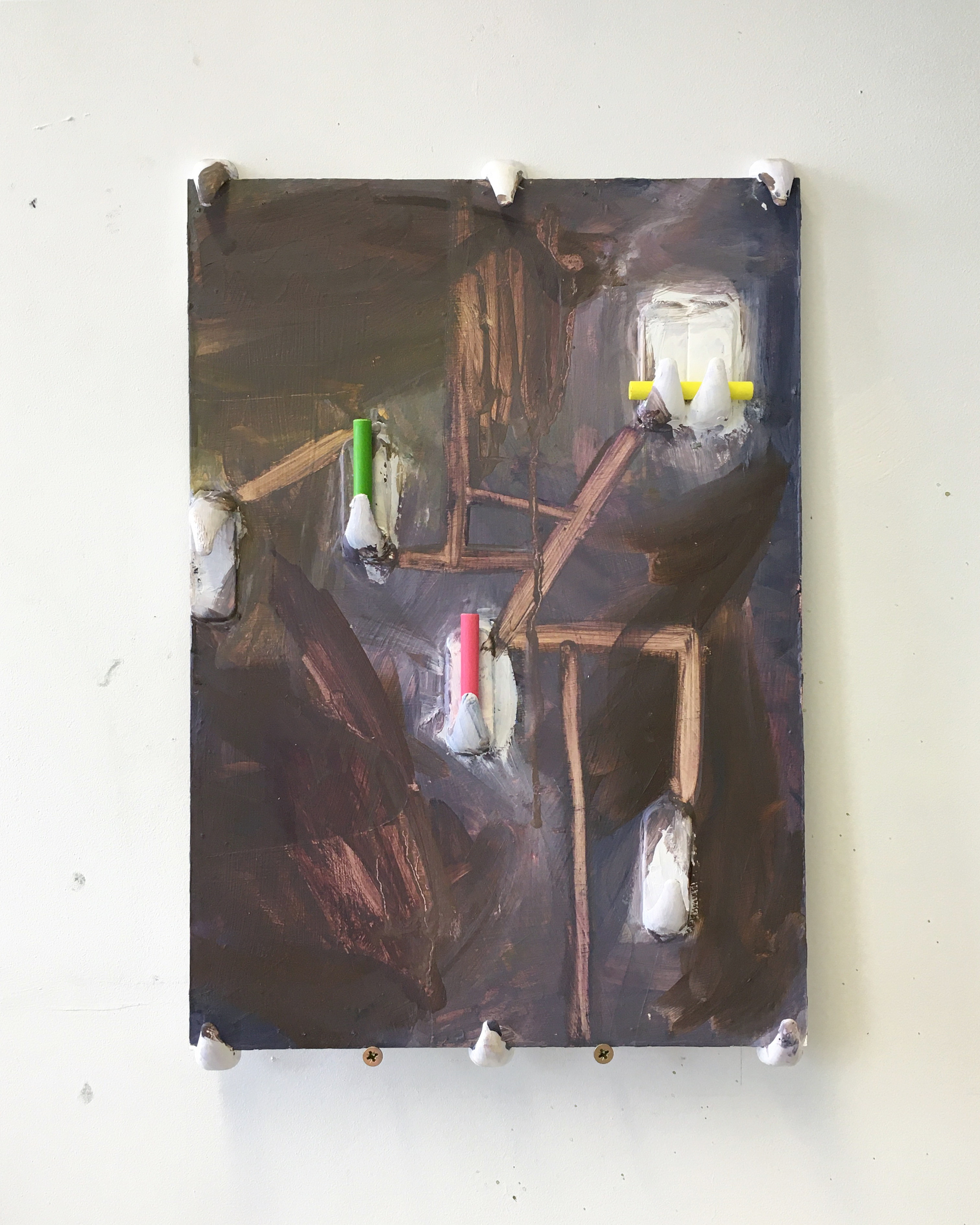 Untitled, oil, pvc hooks and oil pastels on board, 40 x 30cm, 2021
Untitled, oil, pvc hooks and oil pastels on board, 40 x 30cm, 2021I like what you say about painting revealing itself initially, then receding. I am drawn to this idea of hiding from definition, and almost dodging the possibility of being 'about' something in particular, which is something that feels synonymous with painting.
For me this sums up the way I see your work, as at one stage I feel like I have 'got it' from a stylistic perspective, but then another spanner gets thrown in the works...which, for me, is a good thing.
In some of your more recent studio works you have been including plastic hooks and other relief materials. Talk to me a little more about the addition of sculptural elements to your work.
I wouldn’t say I’m actively trying to avoid a meaning or a clear idea of what a painting is about, but I definitely believe the way a painting projects itself comes in ways that are less direct and for lack of a better word, nuanced than “what is it about?”. There’s still many amazing paintings that are very direct, but even then it’s still not so much about the idea in a painting but how that idea is made and how the painting is built up to communicate that idea. I usually find myself liking a painting not because of the subject but because of how that subject is presented. This sounds very cheesy, but I think if you can make an extraordinary painting out of an ordinary subject you’ve done something right. Whereas, you can also have a very interesting/important subject but if you don’t present it in an engaging way then the subject looses its purpose. This is why for me I never think about what a painting could mean whilst I’m making it, I’m more concerned over the how, because it usually hinders the work if I try to force or stick to a meaning.
I also think the idea of “meaning” and what a painting is about can come from less narrative based meanings, and be more process and material based, or even the aura of a work can be its meaning. Artworks, like people have complex characters and personalities, which can tell you things in extremely meaningful and powerful ways, without saying much at all. Sometimes the characteristics I like in a painting are also things I value in people. So it’s more to do with the character or presence of a piece I’m after, over a set meaning. Although I understand those two words are very ambiguous and subjective, but that’s just part of the work aswell. I think sometimes the best way to engage in a painting is when you’re not thinking too much about it. So I don't want people to overanalyse my work, I feel you’re missing the point slightly if you do that. Something that Ben Street wrote about my work in the Freelands Foundation Painting Prize catalogue, that I felt encapsulates it well was “The territory that Whitelock’s paintings seem to claim is this simultaneity of visual information, in which paintings are always speaking in tongues, and are never reducible to a unified reading.”
I like what you say about a spanner getting thrown in the works, because I always try to take the less obvious route when it comes to things like composition and placement etc. as I enjoy the awkwardness in painting when something seems like it shouldn't belong, and hopefully it prevents the work from becoming too easy to read, or at worst, boring. Paintings that are too harmonious or too well put together can feel slightly uncomfortable to me. I think there’s an openness and honesty about work that shows an awkward or vulnerable state to them.
The plastic hooks and more sculptural based materials is another way of incorporating found material and objects that coincide with the found images side of my work, but also act as a way to further pronounce the paintings physicality and the idea of painting as an object in itself. When engaging with a painting it’s not just the image you’re looking at but its the surface, the stretcher, the depth of stretcher, the scale, the wall, the smell, the lighting, the light reflections, the angle you’re looking at at from and a million other things. So once you add something three dimensional to a painting it instantly pushes it into a similar realm of engagement as a sculpture or installation, which I think is important in how we interact with painting, as something that goes beyond just the image. So I use them the same way I would a brush mark or image, such as the colour or form an object has, but with added implications of how the piece is presented and viewed.
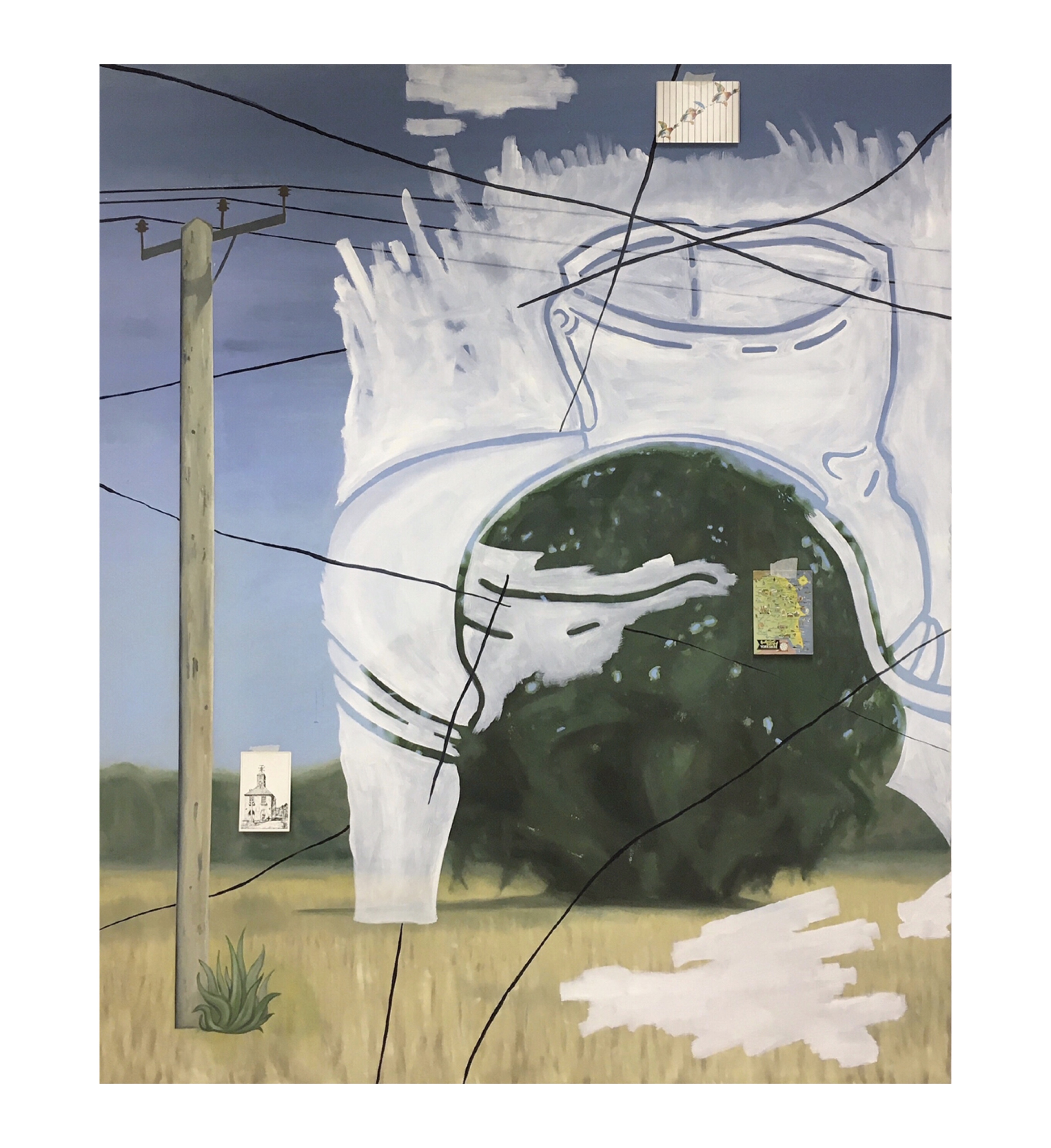
When you were describing similarities between the complexity of how paintings can communicate and the complexities of personal interactions, I couldn't help but think of facial expressions and how they can be the subtle changes that alter how someone appears. Simple gestures resulting in profoundly different readings.
I want to continue the thread that you started to weave about a painting being an object and how you consider it in somewhat of a sculptural sense. I want to delve a little deeper with that and wondered if you could expand a little. I am interested to know whether your relationship to your paintings as objects, and not purely as surfaces, changes your approach to installing the work in exhibitions?
Yeah definitely, paintings are exactly the same in their subtle shifts and changes. Whenever I’m coming up with ideas and compositions, it can sometimes take me by surprise how one small detail or very simple gesture can alter a painting in its entirety. Which makes me realise the unlimited possibilities you not only have with one single decision within a work, but how a painting comes together through of all these different decisions. And how every decision made to prior works has influence on your present work. So I think it’s the idea that everything filters its way through and everything is interconnected in very strange ways. For example in my painting ‘A Place Between’ I used an image of a drawing of a pair of boots from a children’s colouring book. Which was illustrated by someone, who most likely drew them from a real pair of boots, which were made by someone else; who may have bought the materials to make the boots form another person. So it’s this back log and history of images, objects, people, other artworks and myself that filter into my paintings. A new painting I’m about to start on uses an old photograph of my Great Grandpa playing the cello, which makes me think when he had that photo taken he probably never would have thought his great Grandson would make a large abstract painting from it, or to discuss it right now. I think it’s this ability that painting has to give life and new contexts to any kind of visual information that makes it so engaging. It can really command your attention for something you may have never thought about or come across otherwise. So it’s these small personal interactions in life that are all connected, having profound consequences, which is exactly the same for painting.
Through seeing my work as objects in themselves, yeah it definitely has influence on how I think about installing them. I used to do it more a few years ago, where I made double sided paintings that hung from the ceiling and span around or paintings that would be on the wall but connected to the floor through different objects, or compositions spilling onto the wall. I’ve explored it a little recently, and I’m always playing around in my studio how the paintings can be positioned and placed in ways that gives them another context or makes new ways of viewing them. I’ve been trying to use the hooks on my work as a way to hang then from my studio ceiling or hanging loose canvas work like it’s on a washing line. In terms of exhibitions I haven’t really had the chance to explore this much yet, because a lot of the time the installation side of painting isn’t down to you. Also sometimes hanging a painting traditionally flat on a wall is the best way to show it, and it can take quite a specific kind of painting for it to work in a different way. I think it also depends on the space a painting is in, as some spaces could have very interesting architecture that plays well against the work or a certain sized wall or particular kind of light switch, can all change how you see a work. So it’s hard to say how you might want to install a work before you know the space, but hopefully it’s something I’ll have the chance to explore deeper in the future. But I do very much like when a painting is leaned against something, placed on the floor or propped up in an odd way, as it changes how you approach it and how you feel towards it. Due to paintings intense history it can sometimes inadvertently take on a very proud or guarded status, which can feel quite distanced and on edge. Whereas, I think it’s important to feel relaxed and confutable around art, where it invites you in and doesn't intimidate; which is what the installation side of an artwork can do, where it changes its approachability and where you are in comparison to the work. Therefore, I would say it’s to both emphasise their objecthood and materiality, but also to emphasise the spaces they’re in and the type of presence they have. So it’s definitely something I think about and would like to explore more, but with the work I’m making at the moment, I wouldn't say the installation side of it is a key aspect; although that could easily change.
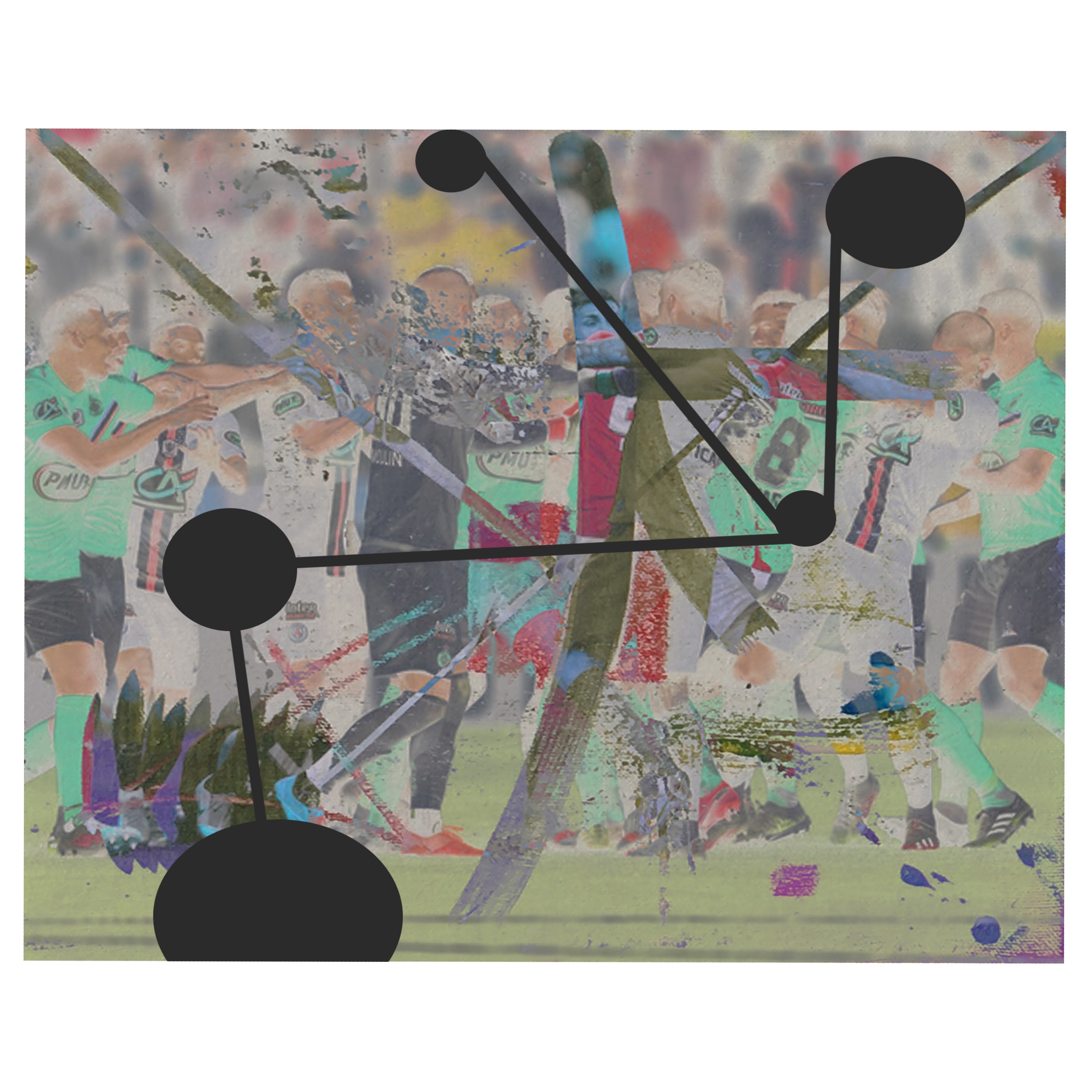
Untitled, digital collage, 2021
So we have chatted about placement a lot, but we haven't really touched upon scale. The works of yours that I am most familiar with are fairly large. How much do you think about scale when approaching a new work and what factors into your decision making around the size of a new painting.
I usually think about scale being more intwined with time and composition. Because I paint relatively quickly, having a larger canvas slows down the process for me, which is important. If I tried to paint some of my larger works on a smaller scale I think they would come out very different, due to how painting large scale uses entirely different motions and applications to painting small or medium scale; and the differences in how it activates your body, both with the artist and the viewer. I suppose during the process there’s a slightly performative element to it, even if no one else sees, there’s a lot of movement and varieties of paces, techniques and applications that translate into the piece, that you can't get from working smaller; because your only really using your wrist and arm, whereas working larger you have to use your whole body from head to toe.
But also just in terms of aesthetics, I decide on the scale of a piece the same way I decide on the colour of a piece or the composition, its all just a process of questions and answers. So I don't think my larger pieces would work on a smaller scale and some of my small pieces wouldn't work larger. The same way changing a colour of a piece would make for an entirely different painting, so would changing the scale. Because the way a painting is made and looks, determines the kind of space it needs, internally and externally. As soon as I make a sketch for an idea, I always imagine what it would be like if it was 10cm to 10 foot, and most of the time it can only work as one size. It also just depends on what kind of experience you want the painting to create. Whether you want it to be overwhelming, delicate, vulnerable or open etc. the scale of a piece can influence these experiences. Also painting large scale is just purely more enjoyable, which is something I value as much as anything!
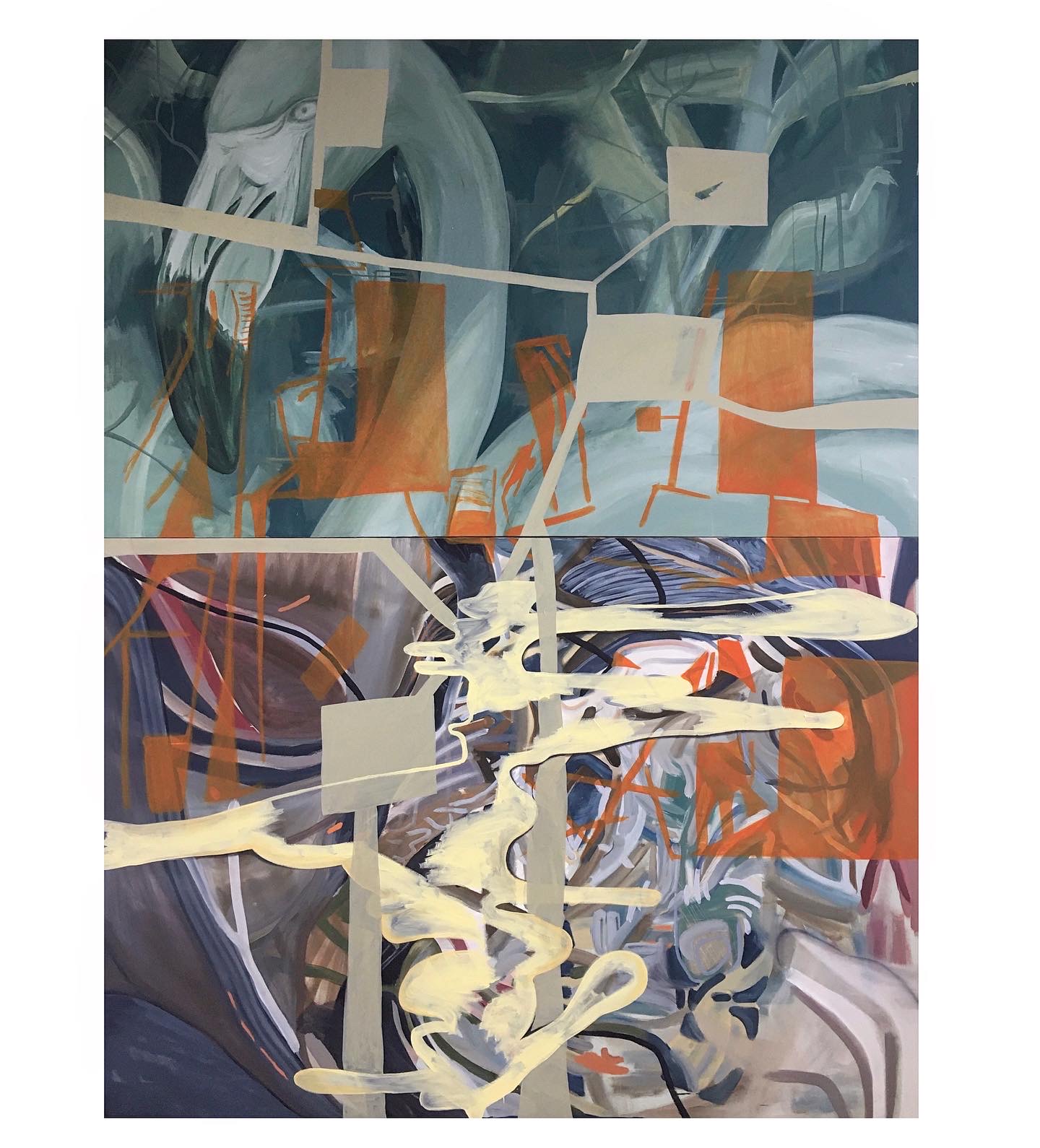 Untitled, oil on canvas, 250 x 190cm, 2021
Untitled, oil on canvas, 250 x 190cm, 2021Do you always make sketches for paintings?
I always make digital collages on Photoshop that I call sketches, but in terms of traditional sketching with pencil on paper I don't do much of. Because of how I make and see my work being built up in layers and forms; I’ve found drawing doesn't translate as well because its much more about line, whereas my work is more about form, composition and layering. So I find making digital collages allows me to move things around much more and it behaves in a similar way to painting where you might block in a section or paint over something, which you can't really do in the same way with drawing. I also make smaller studies which you could call sketches, that I try to make without thinking too much or with any preconceived ideas. But with all my larger paintings I work from digital collages, just to get me going which I might refer to all the way to the end or just use them for the first few moments. Once I have an idea/digital sketch I tend to go straight into painting it, without seeing what it might be like painted small scale, as the intuitive side to the work is equally important. So I wouldn't want any idea of what it might end up like as a painting before I start, because I still want to have this element of not knowing where the painting could go.
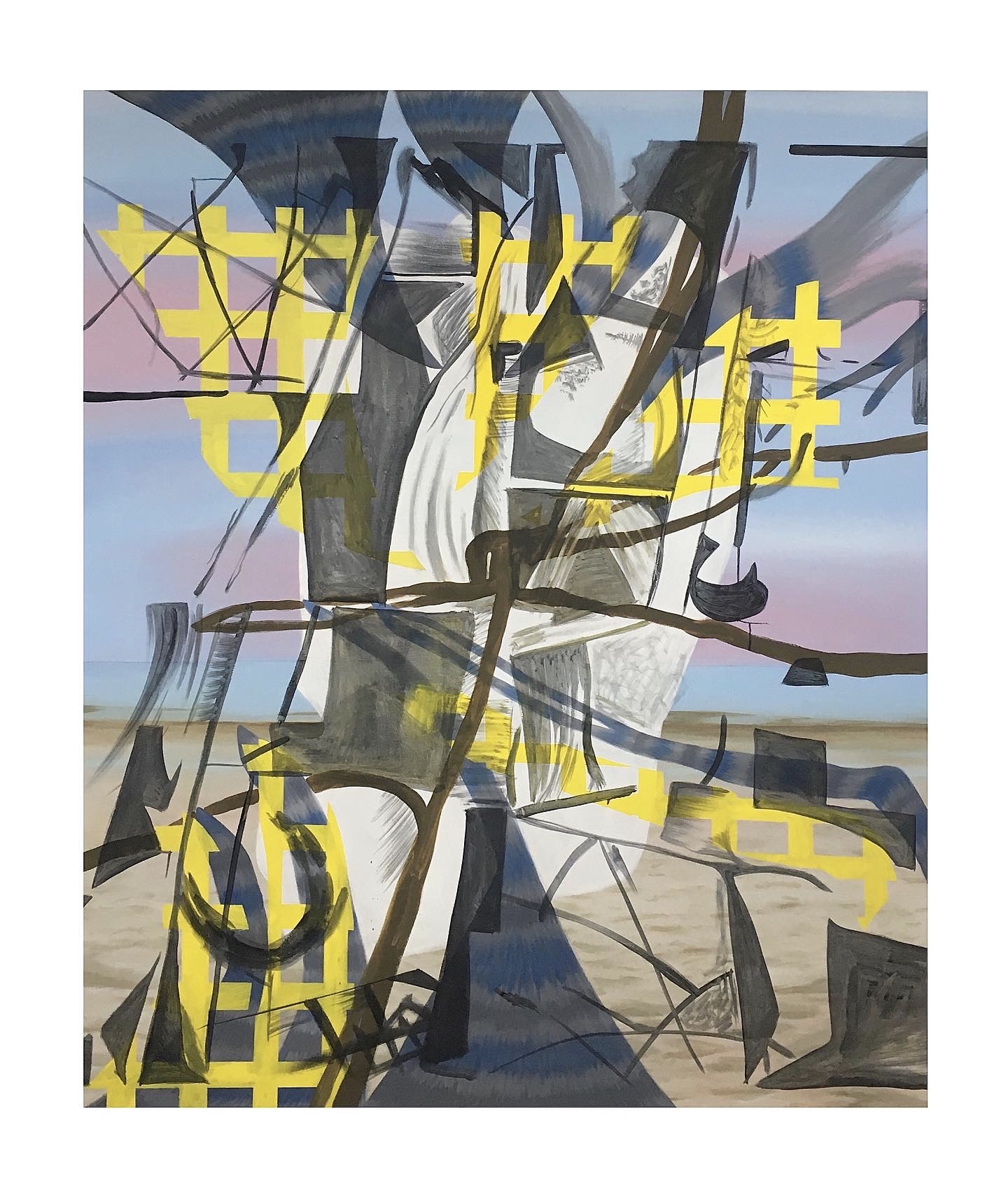 The Death and Birth of Glaucus, oil on canvas, 183 x 153cm, 2021
The Death and Birth of Glaucus, oil on canvas, 183 x 153cm, 2021What's next for you?
I have a few group shows coming up this year and next, the first being in June at Unit 1 gallery in London. This was an open call for anyone who didn't get to have a physical degree show, so myself and about 20 other Edinburgh College of Art graduates applied for, and were chosen as one of the 4 groups. This will be from 3rd to the 7th June 2021, which is very exciting, and I’ll be showing my painting ‘The Death and Birth of Glaucus’ that I painted in February. Then two more group shows coming up, both being at the Royal Scottish Academy in Edinburgh; are the RSA New Contemporaries, which was meant to be this February but has been pushed to February 2022, that consists of about 10-15 graduates from each art school in Scotland. And the other show at the RSA is the Society of Scottish Artists New Graduate Award, which is another Scottish art school graduates show, that will be happening in October 2021. Another exciting thing I have coming up soon is an online residency with The New Artist, created by Alexandra MacKay, where I’ll be sharing my work on their Instagram (@_the_new_artist) and website (www.thenewartist.co.uk) over June this year. So some exciting things are lined up that I’m very much looking forward to!
-
@j_whitelock
-
If you like this why not read our interview with Chris Thompson.
-
© YAC | Young Artists in Conversation ALL RIGHTS RESERVED
